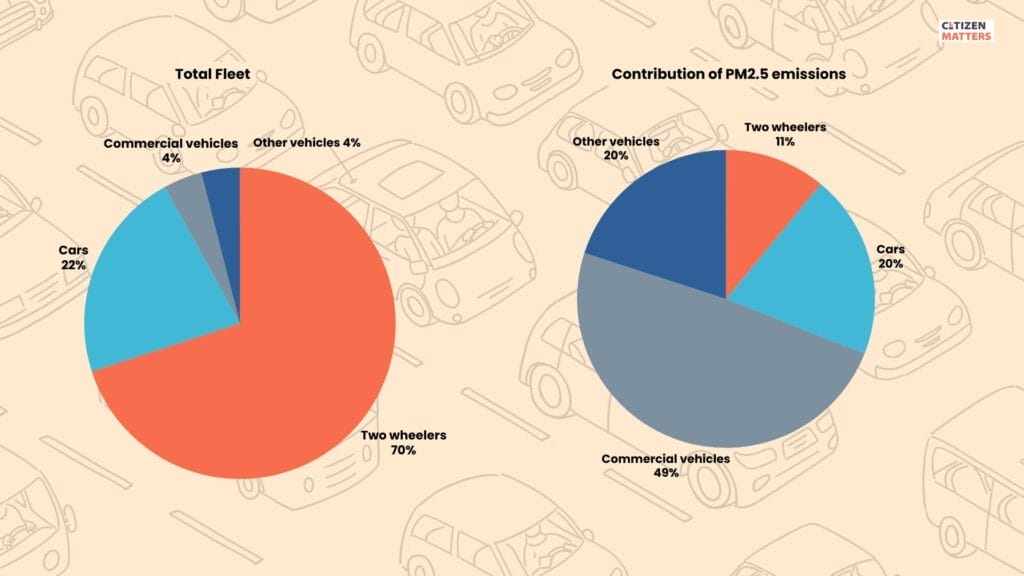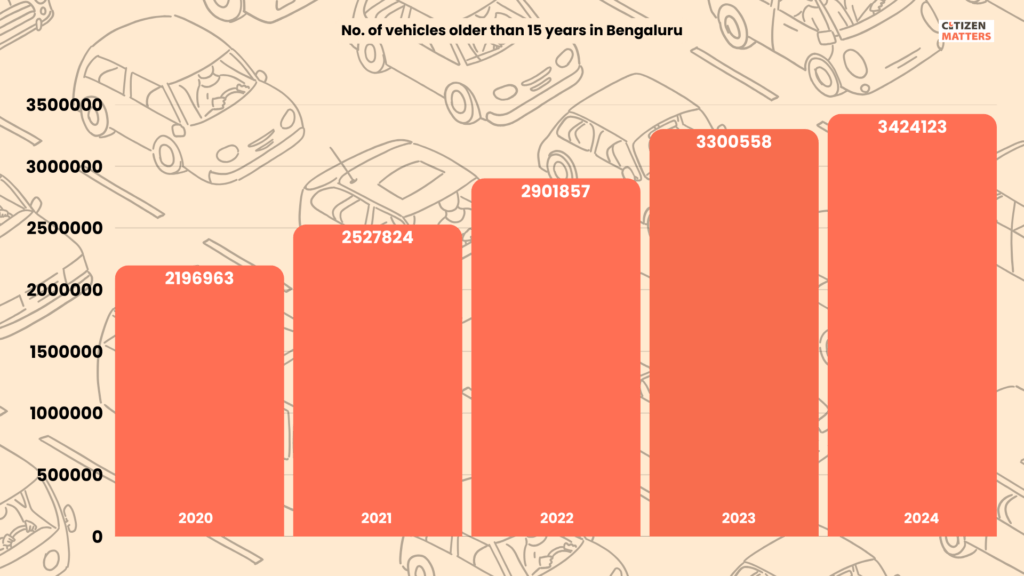A long weekend drive on the highway sounds like a good way to unwind, but the massive, often overloaded trucks and other commercial vehicles belching black-grey smoke can make city roads less pleasant.
While commercial vehicles are crucial for the supply of essential goods across cities, they also cause major pollution. In Bengaluru, commercial vehicles make up just 4% of the total vehicle population but contribute a staggering 49% of the city’s PM2.5 vehicular emissions.
A recent study published by the National Institute of Advanced Studies (NIAS) revealed this fact.
Particulate matter from vehicle emissions penetrates deep into the lungs and contributes to diseases like asthma, cardiovascular issues, and bronchitis. Pollutants not only severely impact public health, but also the earth’s climate and ecosystems. Ozone, formed from reactions between nitrogen oxides, carbon monoxide and hydrocarbons, emitted from vehicles, along with sunlight inflames airways and scars lungs with prolonged exposure.
While pollution from commercial vehicles can have an impact on health and the environment, the policies and regulatory mechanisms to control the pollution are not strictly enforced. This calls for targeted interventions to tackle the city’s worsening air quality.
Commercial vehicles: The heavy polluters
According to the study, the transport sector contributes to 39% of PM2.5 pollution in the Bengaluru Urban District (BUD) region. And an enormous 48% in the entire Bruhat Bengaluru Mahangara Palike (BBMP) region. Moreover, 24% of the PM10 in the BUD region comes from the transport sector.
To delve deeper into the findings, we spoke with Gufran Beig, the author of the study. “Overloading of commercial vehicles and poor maintenance of diesel engines are major factors driving higher emissions from commercial vehicles,” says Dr Beig. He also notes that the presence of old vehicles and ineffective emission norms compound the problem, allowing these highly polluting means of transport to stay on Bengaluru’s roads.
The efficiency of commercial vehicles is also influenced by the weight of the freight they carry. Overloading these vehicles significantly reduces their efficiency, leading to higher emissions.
Sharvari Sujay Patki, Associate Director, WRI India, sheds light on why commercial vehicles are such heavy polluters. “Long-haul trucks, on average, run about 300-400 kilometres daily. Commercial vehicles, especially medium and heavy-duty trucks, often have lower fuel efficiency compared to smaller vehicles, in addition to covering longer distances. Their fuel efficiency is typically low due to the heavy loads they carry,” says Sharvari.

Transitioning to rails and cleaner vehicles
Road transport is the dominant mode of freight transport in India, accounting for 71% of the industry, while the share of rail freight is just 17.5%. Sharvari highlights the missed opportunity in this imbalance. “It should be the other way around,” she explains, noting that rail transport is majorly electrified. Double-stack cargo movement — where two layers of containers are stacked on top of each other on a freight train — is far cleaner and more efficient than road transport.
“We need to make a conscious effort to shift a greater share of freight transport to rail. This transition is crucial to address the growing emission problem.” Powered by economic growth, requirements for freight movement have increased. So, this may not even affect the livelihood of the freight ecosystem as road freight will still be critical for first and last-mile connectivity, she adds.
The age of vehicles is another critical factor contributing to emissions. While large logistics service providers typically maintain younger fleets, using their trucks for an average of 8 to 10 years, these vehicles often end up in second-hand markets.
“Buyers in the second-hand market use these trucks for a longer period, often unaware that the efficiency of older vehicles is significantly lower, which, in turn, reduces their profitability,” explains Sharvari. As vehicles age, their maintenance costs and fuel consumption increase, making them less cost-effective. This not only raises operating costs but, also slows the adoption of newer, cleaner emission standards. To tackle this issue, it’s essential to highlight the inefficiency of ageing vehicles and the importance of regularly updating fleets.
Read more: Bengaluru’s climate challenge: How the city can reduce its carbon footprint
Need to phase out older vehicles
As of March 2023, Karnataka alone had 87,48,963 vehicles which are 15 years or older. This is the highest among all Indian states. The entire country has 6,11,23,468 vehicles which are 15 years or older. Experts believe that transitioning to electric vehicles (EVs) could be a transformative solution to this growing issue.
The PM E-DRIVE scheme mandates the scrapping of older vehicles as a prerequisite for claiming incentives on electric vehicles — a move designed to replace polluting vehicles with zero-emission alternatives. This approach adds one zero-emission vehicle to the fleet while removing one polluting vehicle.

Steps to reduce emissions
“The emission norms for commercial vehicles and the regulatory authorities’ control over them is not very efficient. There is no regular mechanism for these vehicles to undergo examination in a prescribed frequency,” says Ashish Verma, Professor and Convenor of Sustainable Transportation Lab, Indian Institute of Science.
Apart from the emission standards, the regulatory mechanism to assess the roadworthiness of these vehicles from a road safety perspective is crucial. Such checks are essential not only to enhance vehicle maintenance but also to achieve meaningful reductions in emissions, he says.
The International Roads Federation (IRF) has urged India’s Bureau of Energy Efficiency (BEE) to establish stringent regulations to reduce carbon emissions from heavy commercial vehicles (HCVs), which currently lack specific emission or fuel efficiency standards to control pollution.
Despite setting a minimum fuel efficiency target for HCVs in 2017, India has not updated this target, and it remains unmet. Major countries have committed to cutting down emissions from HCVs. Europe aims to slash carbon dioxide emissions from HCVs to 90 per cent by 2040 compared to the 2019 baseline. While the BEE is in discussions to implement the third version of Corporate Average Fuel Efficiency (CAFE) norms for carmakers, similar measures exclusively for HCVs are yet to be addressed.
Read more: PM2.5 pollution: Why Bengaluru urgently needs hyperlocal air quality monitoring
Immediate action: Strict regulatory norms
While transitioning could help reduce emissions over time, immediate action should be taken to introduce stringent emission norms and mechanisms to regulate polluting commercial vehicles.
A study analysing the impact of India’s Bharat Stage (BS) mitigation measures found a reduction in CO, NMVOC, OC, and BC emissions between 2017 and 2021. However, it also revealed a troubling 4.9% increase in NOx levels during the same period. “Most of the commercial vehicles being diesel-powered vehicles could be a reason for the rise in NOx levels,” Ashish points out.
Sharvari adds that CNG vehicles, often considered a cleaner alternative, are also significant emitters of NOx pollutants. Experts also suggest the need for adequate weighing facilities to determine if these vehicles are overloading.
The development of road infrastructure like flyovers, elevated corridors, and tunnel roads also escalates the problem of high emissions from commercial vehicles. These road development projects have led to longer distances that heavy-duty commercial vehicles need to travel. Route optimisation and developing multi-modal transportation planning are significant, say experts.
The National Clean Air Programme was launched in 2019, to improve air quality by 20%–30% in five years. However, studies suggest that the air quality is declining and way poorer than WHO standards. Policies to control pollution from commercial vehicles such as strict emission norms, scrapping of end-of-life vehicles, imposing fines on poorly maintained vehicles, and regulatory mechanisms to address overloading of freight trucks must be strictly implemented and consistently enforced. Proper infrastructure for the effective execution of these norms must also be put in place.
What can we do for cleaner air?
Measures to control emissions from commercial vehicles
- Strictly avoiding overloading of freight vehicles
- Ensuring proper maintenance of commercial vehicles
- Scrapping of vehicles older than 15 years
- Regulating emission standards and strict emission norms
- Transitioning to rail freight transport and cleaner vehicles